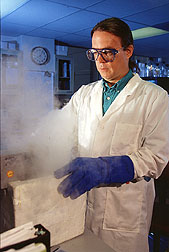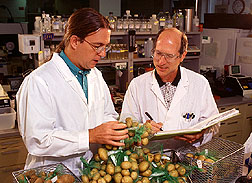New Safeguards Against Glycoalkaloids
Techniques help plant breeders detect and reduce their occurence in food crops.
|
|
Breeders of new kinds of tomatoes, potatoes, and eggplants for farms and gardens might soon have a faster and easier way to test promising plants for troublesome natural compounds called glycoalkaloids. And a new, gene-based strategy may help blunt plants' ability to form those compounds in the first place.
These two new developments from Agricultural Research Service laboratories in Texas and California should offer additional safeguards against glycoalkaloids. They should also hasten breeding and screening of these vegetables, not only by ARS plant breeders, but also by colleagues at universities and at vegetable seed companies worldwide. Thousands of new tomatoes and potatoes, for instance, are screened by breeders every year in the ongoing quest for outstanding flavor, superb texture, or other prized qualities.
Biologist Larry H. Stanker and chemist Carol K. Holtzapple, with ARS at College Station, Texas, and chemist Mendel Friedman at the ARS Western Regional Research Center in Albany, California, have patented a laboratory-built protein that could become the basis for a rapid, simple, accurate test for glycoalkaloids.
Known as a monoclonal antibody, the protein seeks out and binds to key alkaloids in potatoes, tomatoes, and eggplants. These crops belong to a botanical family known as solanaceous plants, after the Latin name for the group, Solanaceae. The scientists named the antibody "Sol-129."
The idea of using monoclonal antibodies to detect glycoalkaloids isn't new. But the ARS-developed antibody is apparently the first to do this job for all three crops.
Stanker and Holtzapple are in the ARS Food and Feed Safety Research Unit at College Station. Friedman is in the Food Safety and Health Research Unit at Albany.
What a Test Like This Might Do
The new antibody can be used to ensure that top-performing potatoes from plant breeding experiments, for example, don't exceed the generally accepted safe limit of 20 milligrams of glycoalkaloids for each 100 grams of fresh potato.
Unlike some other options, a test that relies on the new monoclonal antibody would not require expensive laboratory instruments, costly organic solvents, or a highly trained staff to run equipment and analyze results.
A New England company, EnviroLogix, Inc., of Portland, Maine, is working with the scientists to package the antibody in an affordable, easy-to-use test kit. The company has a cooperative research and development agreement with the agency.
A reliable and portable test might be especially useful for potato breeders. They regularly use wild potatoes as parents of new kinds of spuds for baking or for processing into french fries, chips, dehydrated potato flakes, or other products.
"Potato breeders," says Stanker, "want to give commercial potatoes the best traits of their wild relatives, such as resistance to a certain insect or disease. But wild potatoes typically have higher glycoalkaloid levels. This test would simplify the task of making sure that the level in the experimental potatoes is okay."
Gene Thwarts Glycoalkaloids
Potatoes of the future may manufacture less glycoalkaloids if they contain the rebuilt form of a gene newly found and copied at Albany.
Charles P. Moehs, formerly with ARS at Albany, did the work with co-researchers Friedman and Paul V. Allen of the Food Safety and Health Research Unit; William R. Belknap and David R. Rockhold of the Crop Improvement and Utilization Research Units, also at Albany; and Andrew Stapleton, who is now at Bio-Rad Laboratories in Hercules, California.
In nature, the gene cues the plant to make an enzyme called solanidine UDP-glucose glucosyltransferase. The plant must have that enzyme in order to produce a key glycoalkaloid, alpha-chaconine.
The researchers have inserted backwards, or antisense, copies of the gene into potato tissue and have nurtured the tissue in healthy plants. "The presence of the antisense gene," says Belknap, "results in degradation of the message conveyed by the natural gene. As a result, plants make fewer glycoalkaloids."
That's what happened in preliminary lab and greenhouse tests with about a dozen of the genetically engineered plants. Belknap leads that research.
His team has provided several hundred of the transgenic tubers for outdoor testing in Idaho. In late 1997, plant pathologist Dennis L. Corsini and geneticist Joseph J. Pavek harvested their first crop of the bioengineered plants from an experimental field near their laboratory. They are in the ARS Small Grains and Potato Germplasm Research Unit at Aberdeen. They'll test the high-tech tubers not only for low glycoalkaloid levels, but also for other key indicators of quality.
In the meantime, Belknap's Albany team is readying new combinations of the gene and the promoters that turn the gene on or off. The best of these configurations will become candidates for more tests next summer in Idaho. — By Marcia Wood
For more information on U.S. Patent 5,614,408, "Monoclonal Antibodies to Potato, Tomato, and Eggplant Glycoalkaloids and Assays for the Same," contact Larry H. Stanker, USDA-ARS Food and Feed Safety Research Unit, 800 Buchanan Street, Albany, CA, 94710; phone (510) 559-5984
For information on U.S. Patent Application No. 08,797,226, "DNA Sequences Encoding Solanidine UDP-Glucose Glucosyltransferase and Use to Reduce Glycoalkaloids in Solanaceous Plants," contact William R. Belknap, USDA-ARS Crop Improvement and Utilization Research Unit, Western Regional Research Center, 800 Buchanan St., Albany, CA 94710; phone (510) 559-6072








